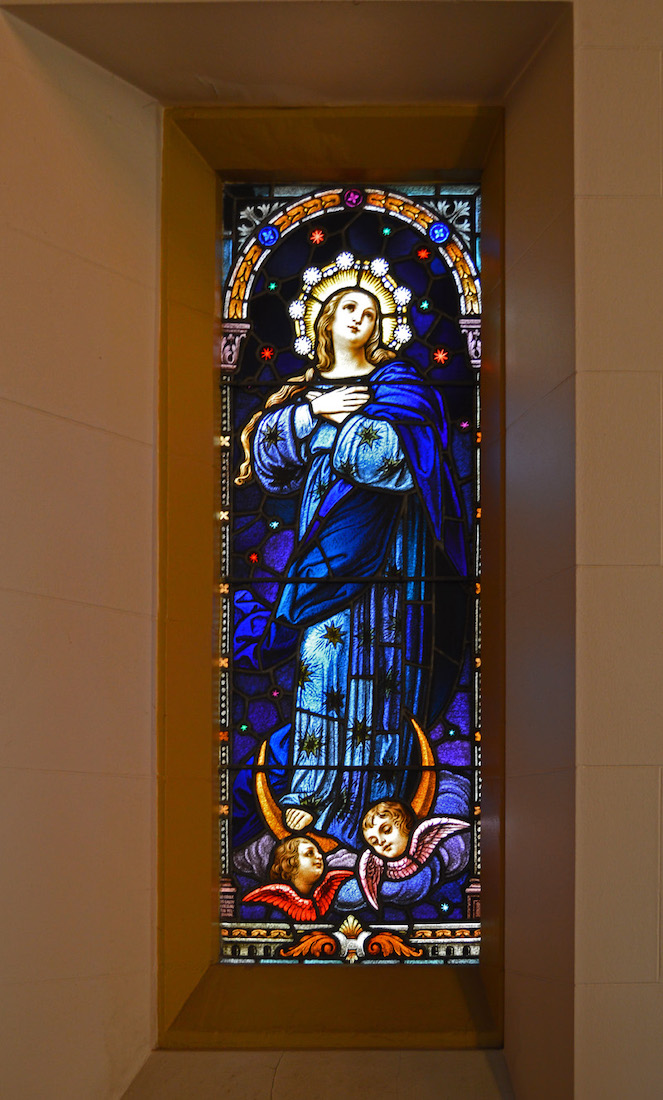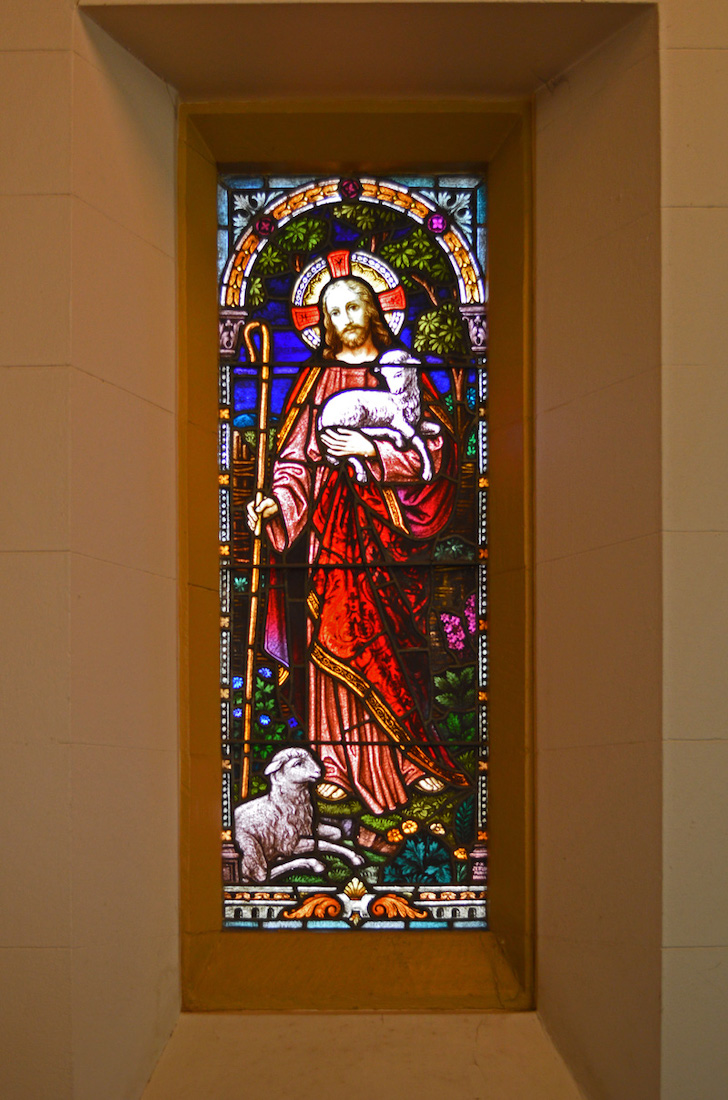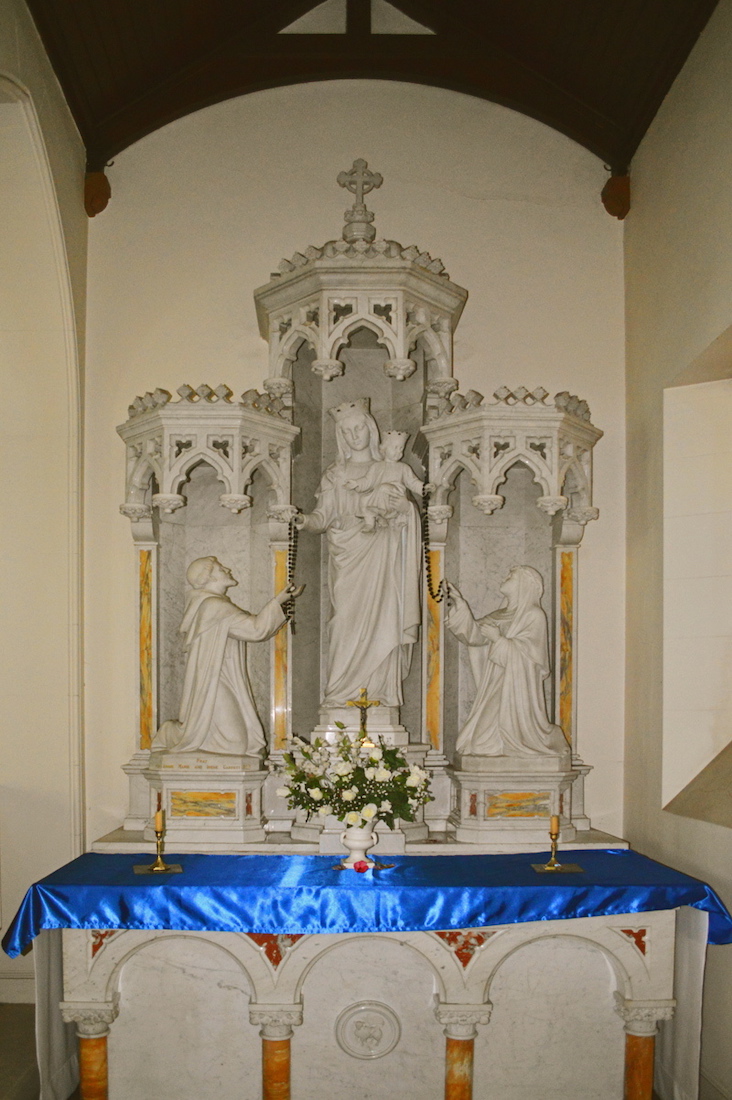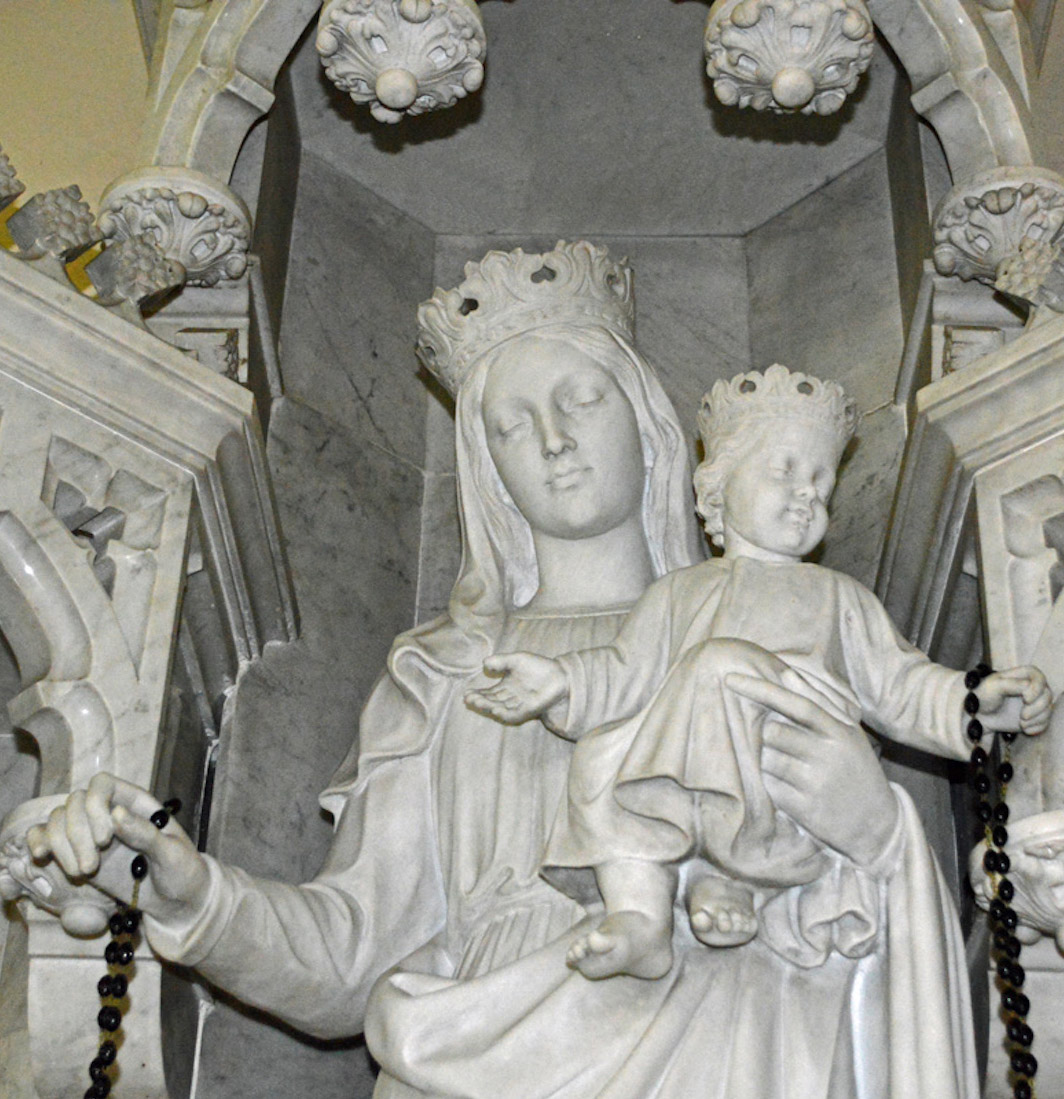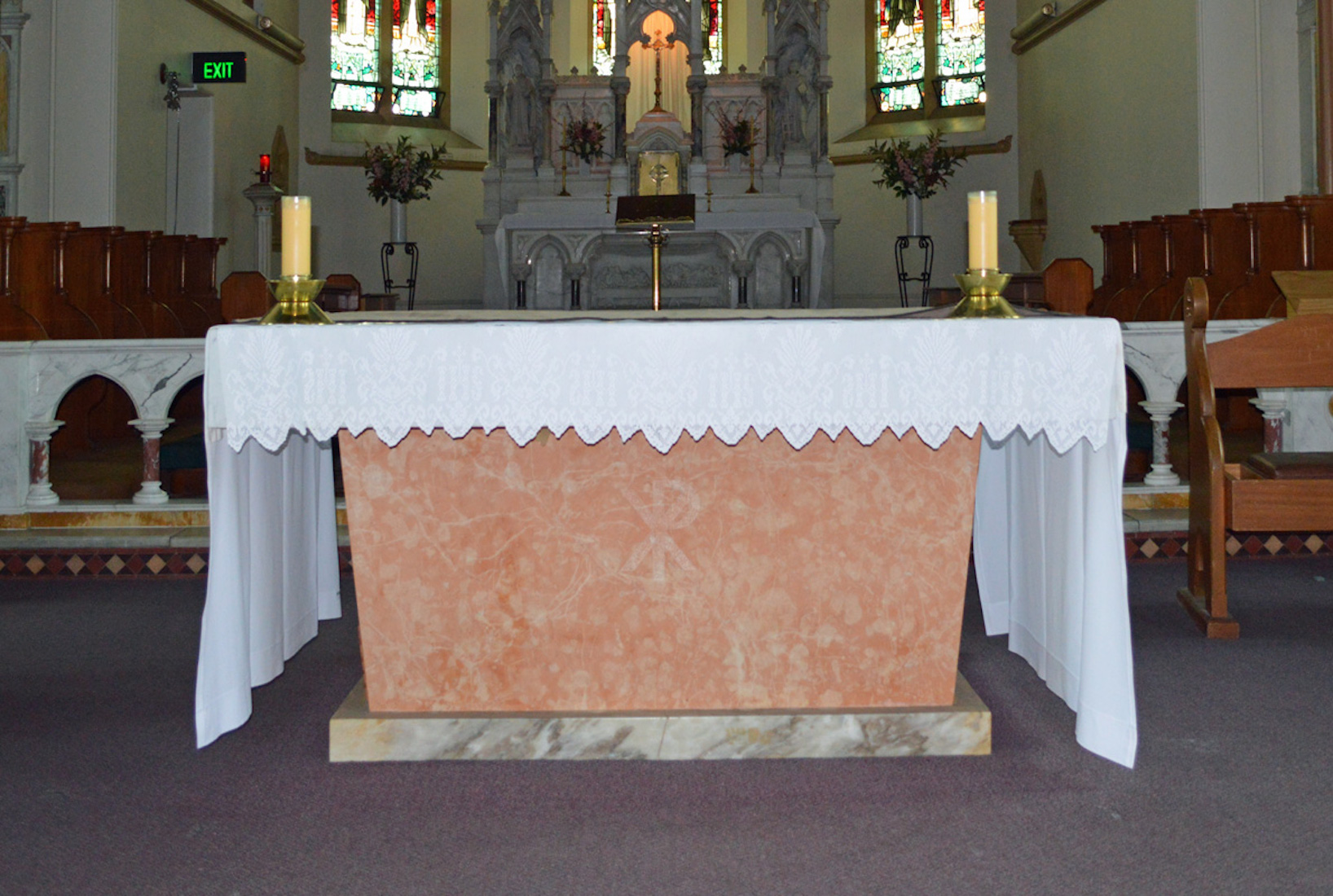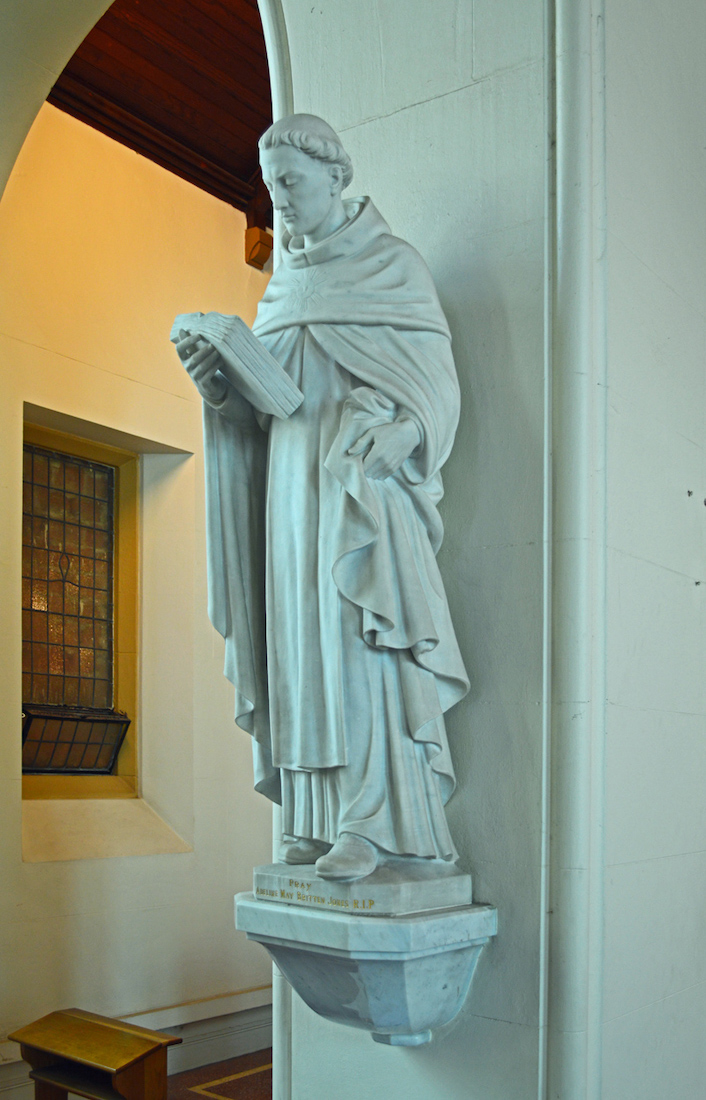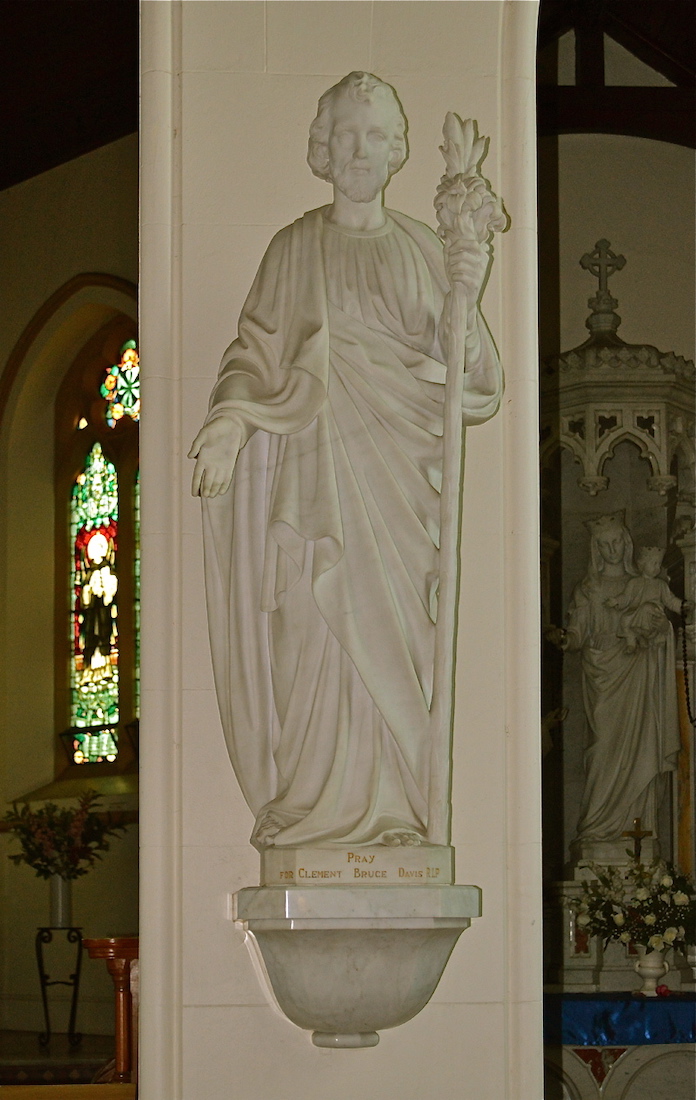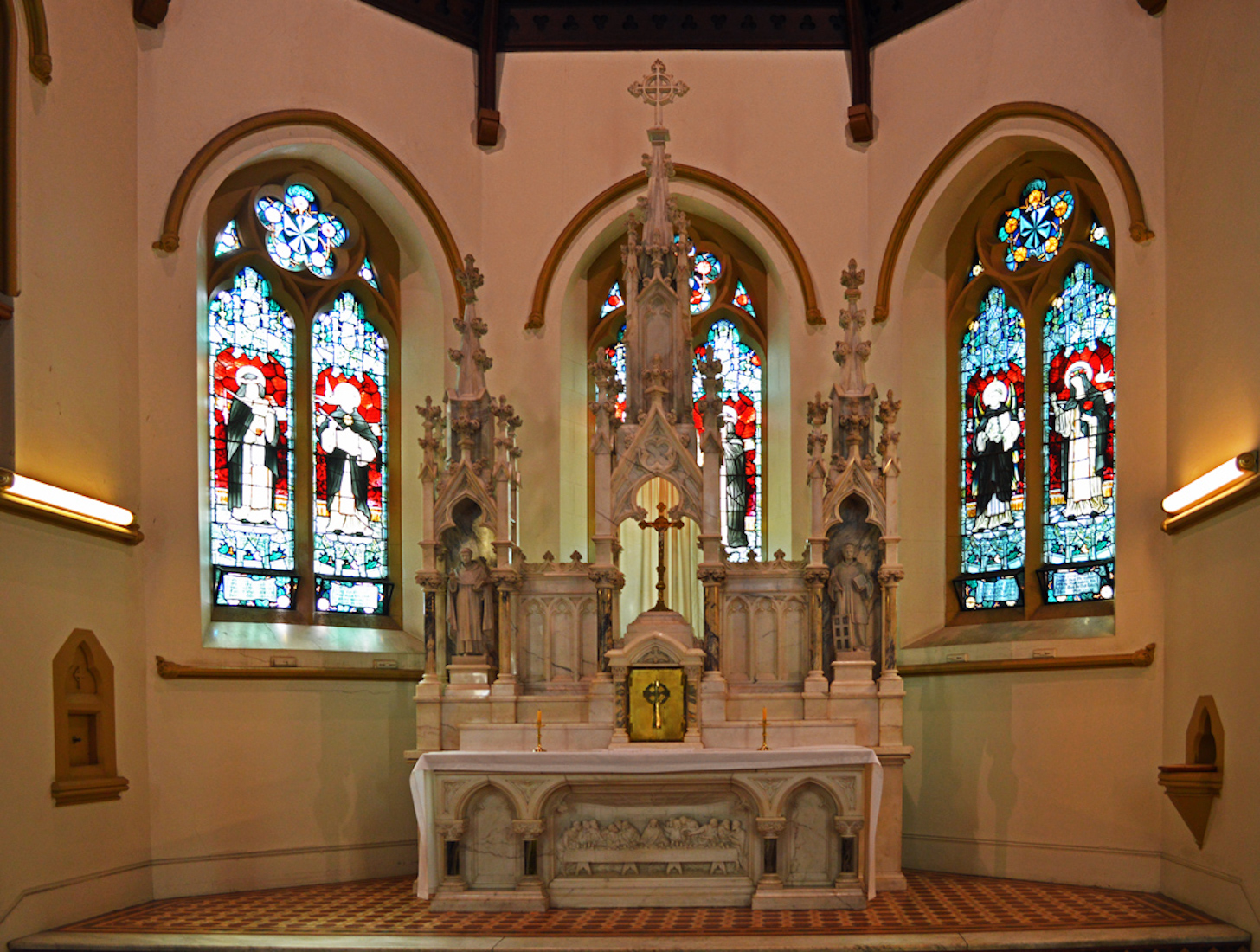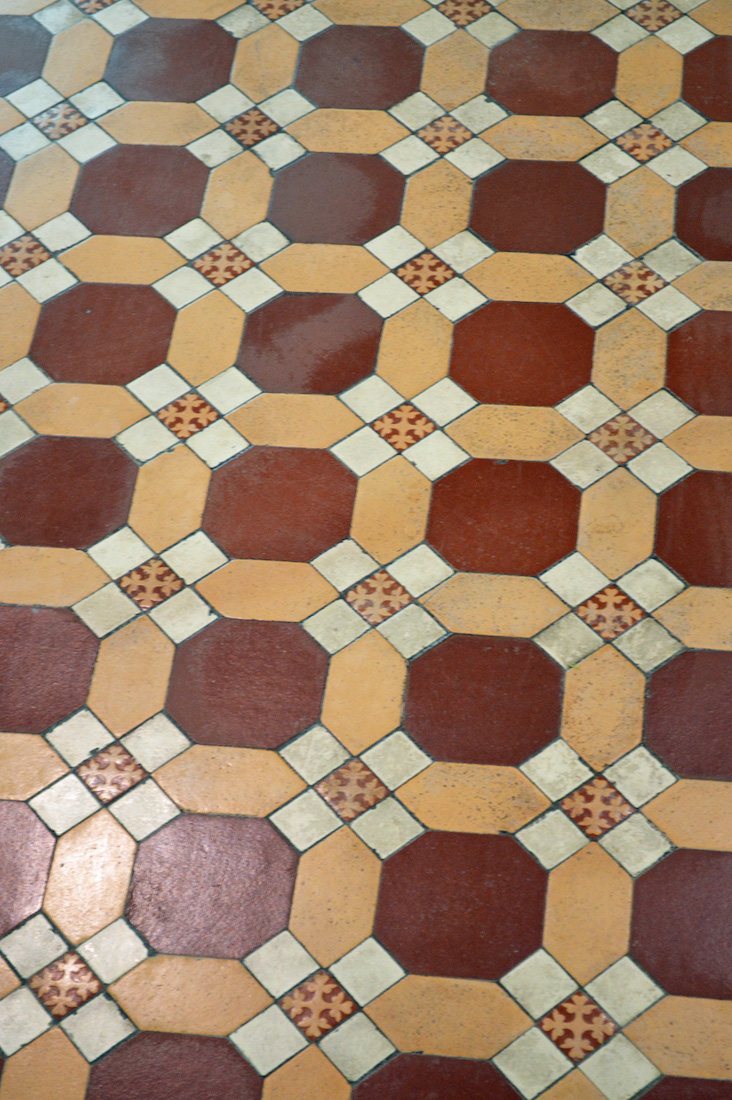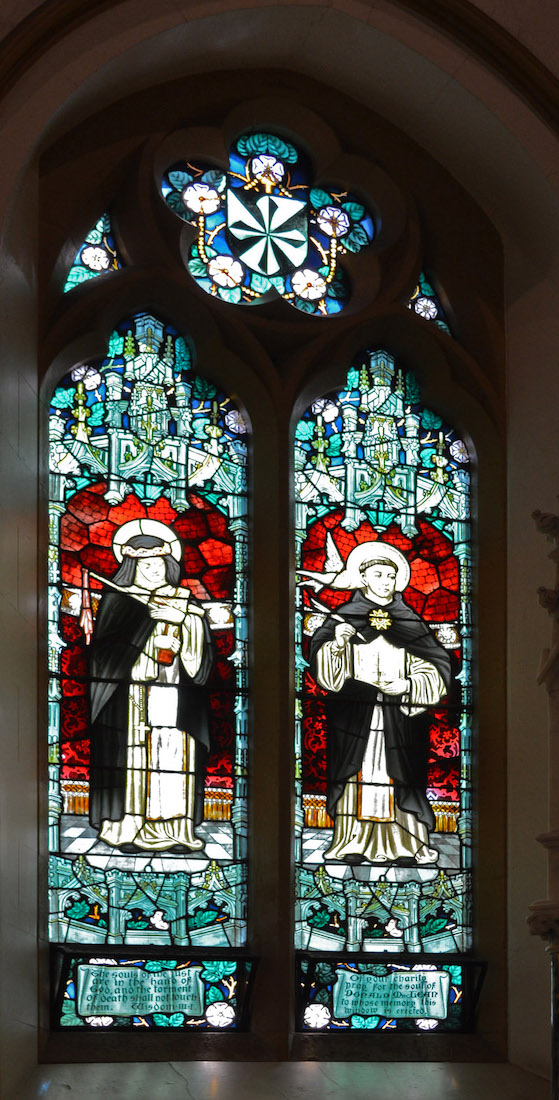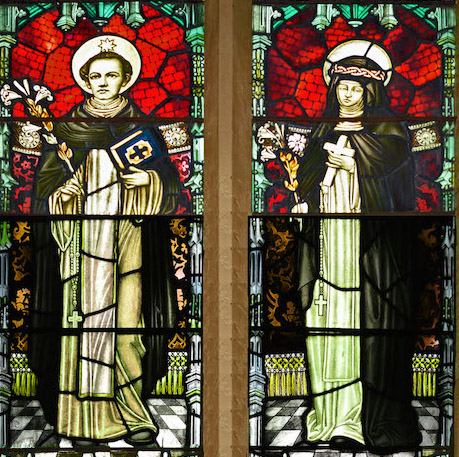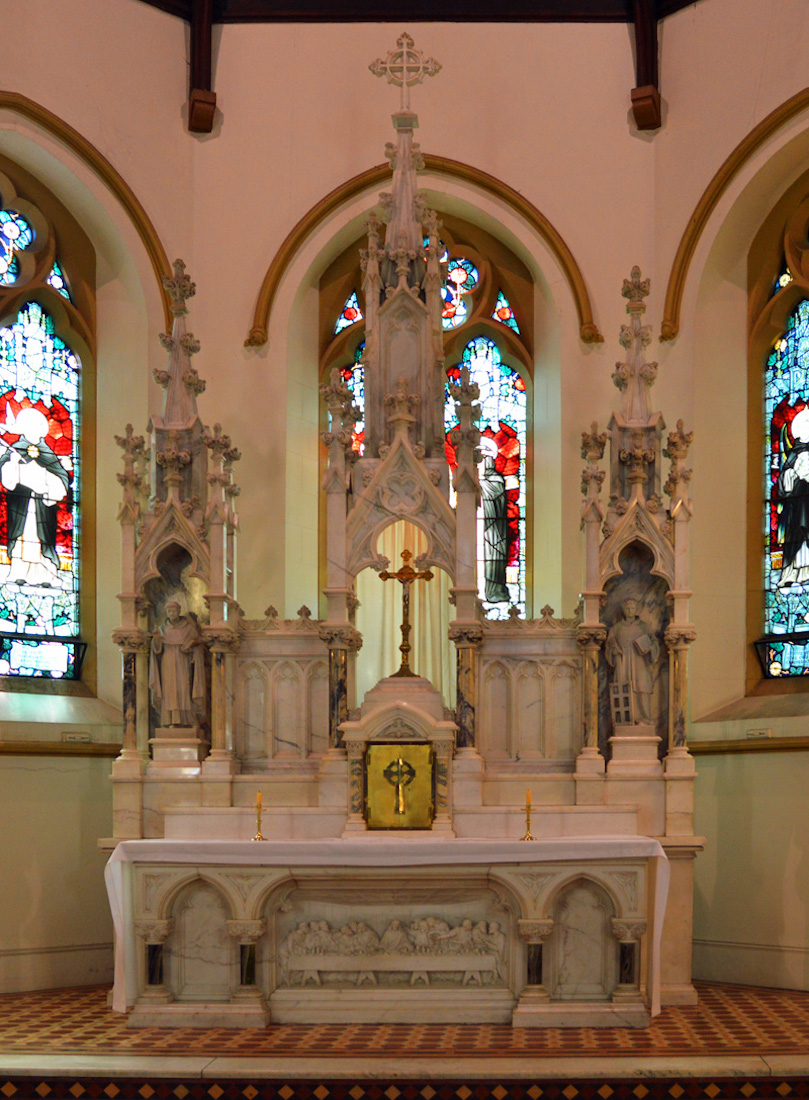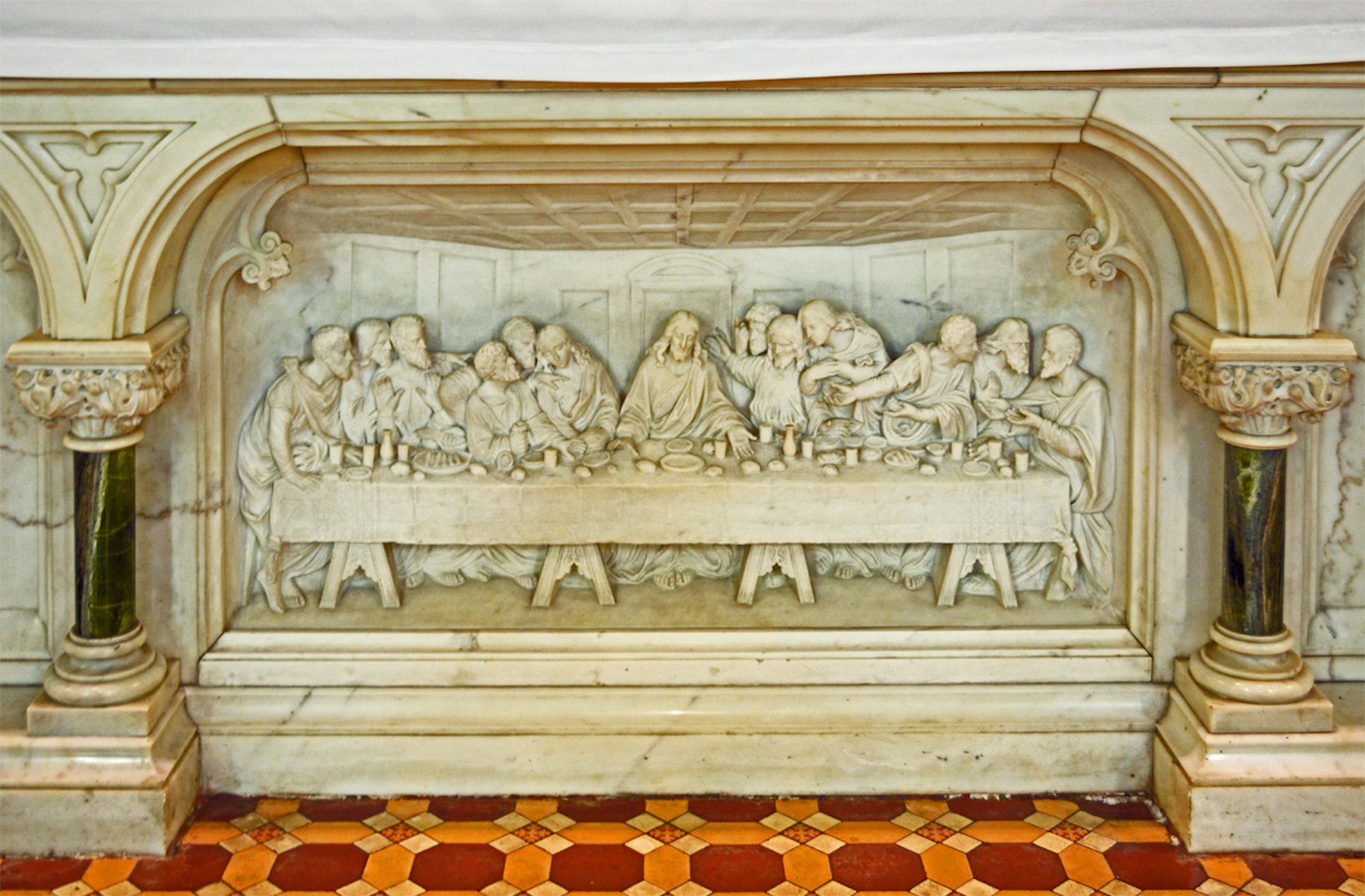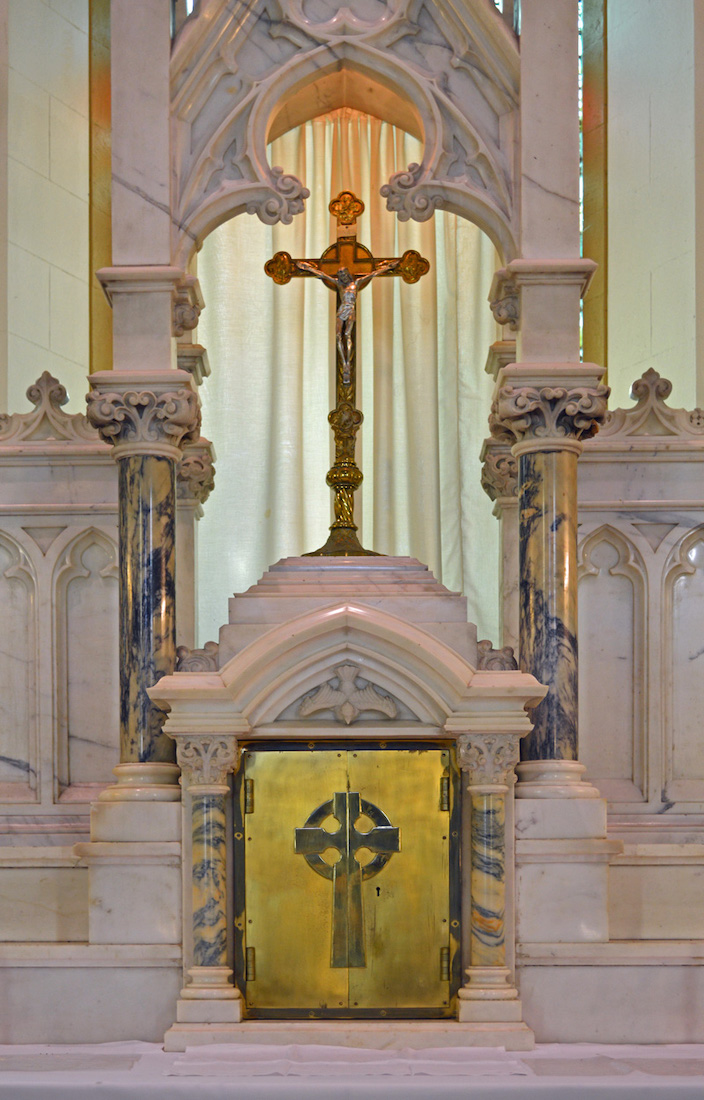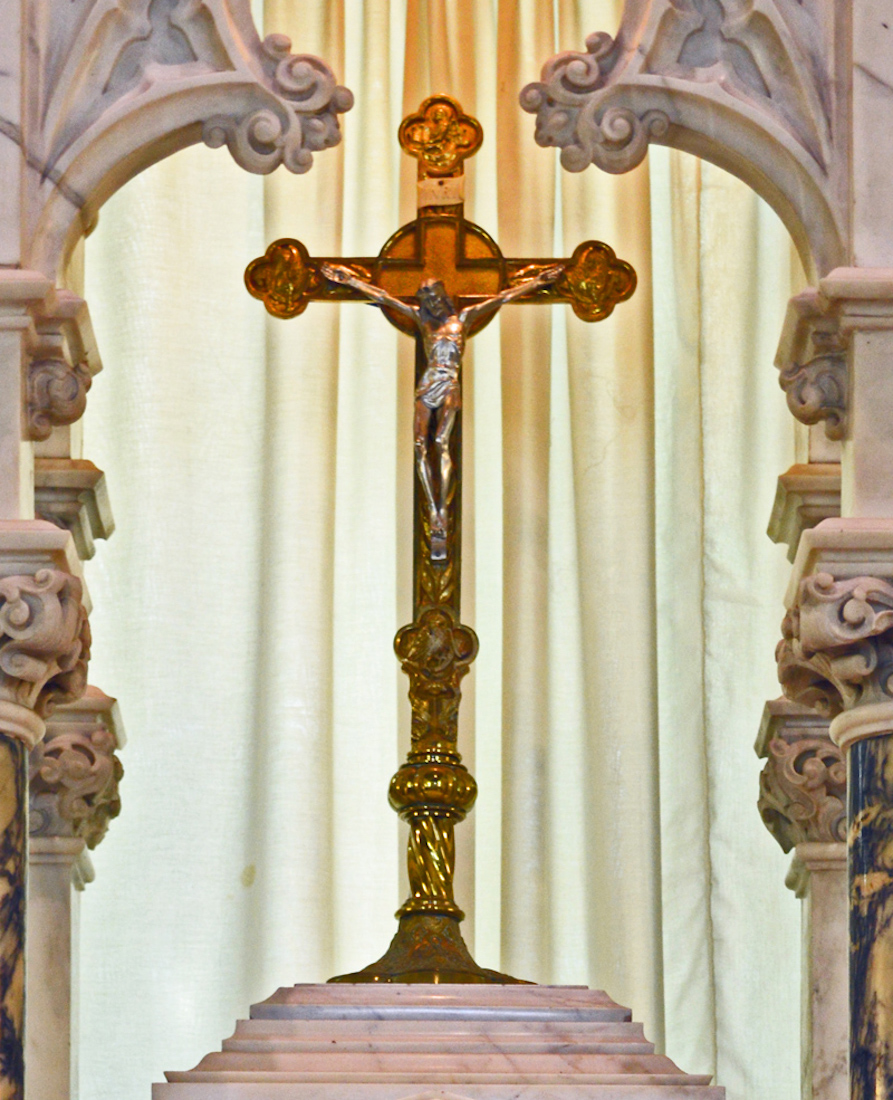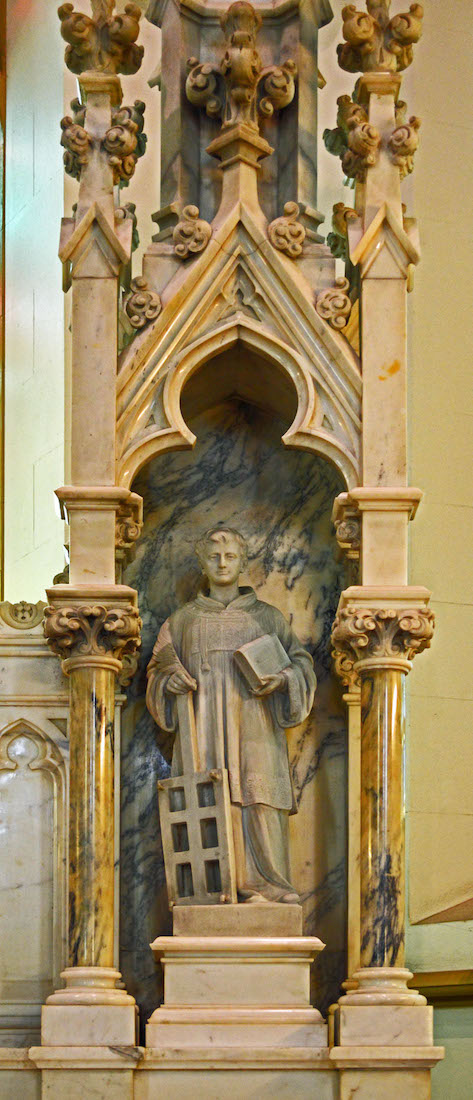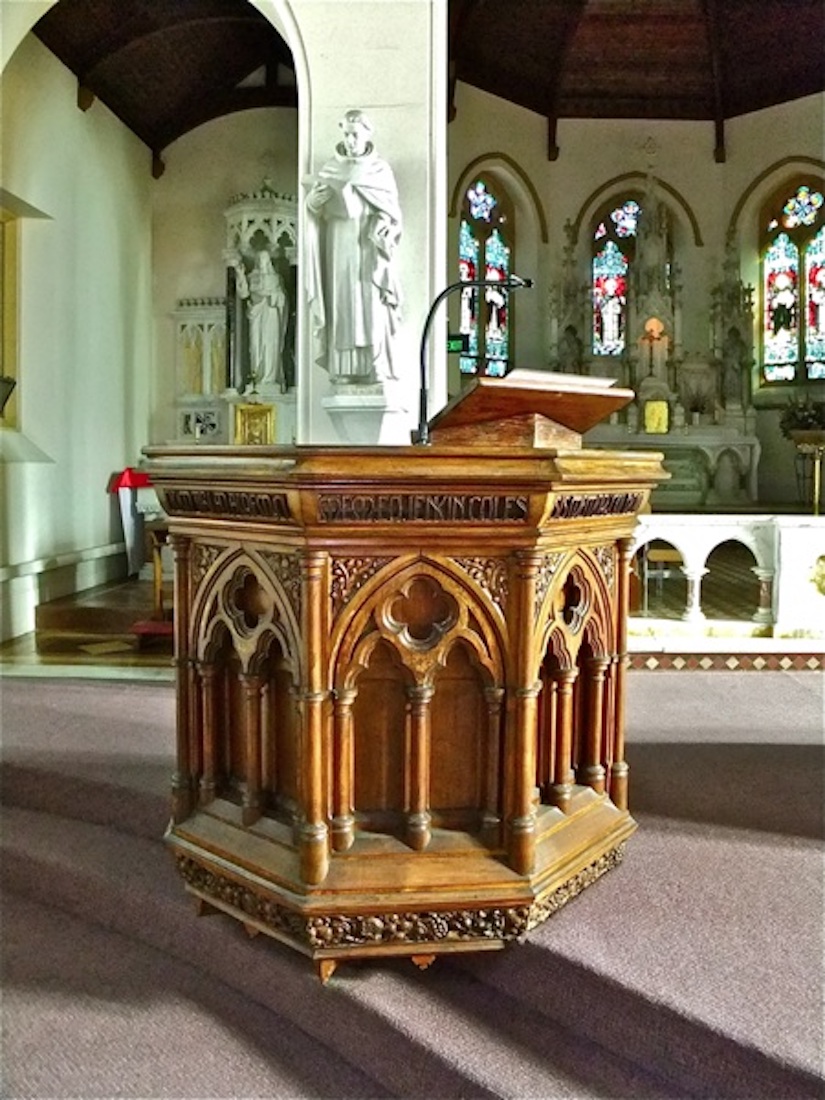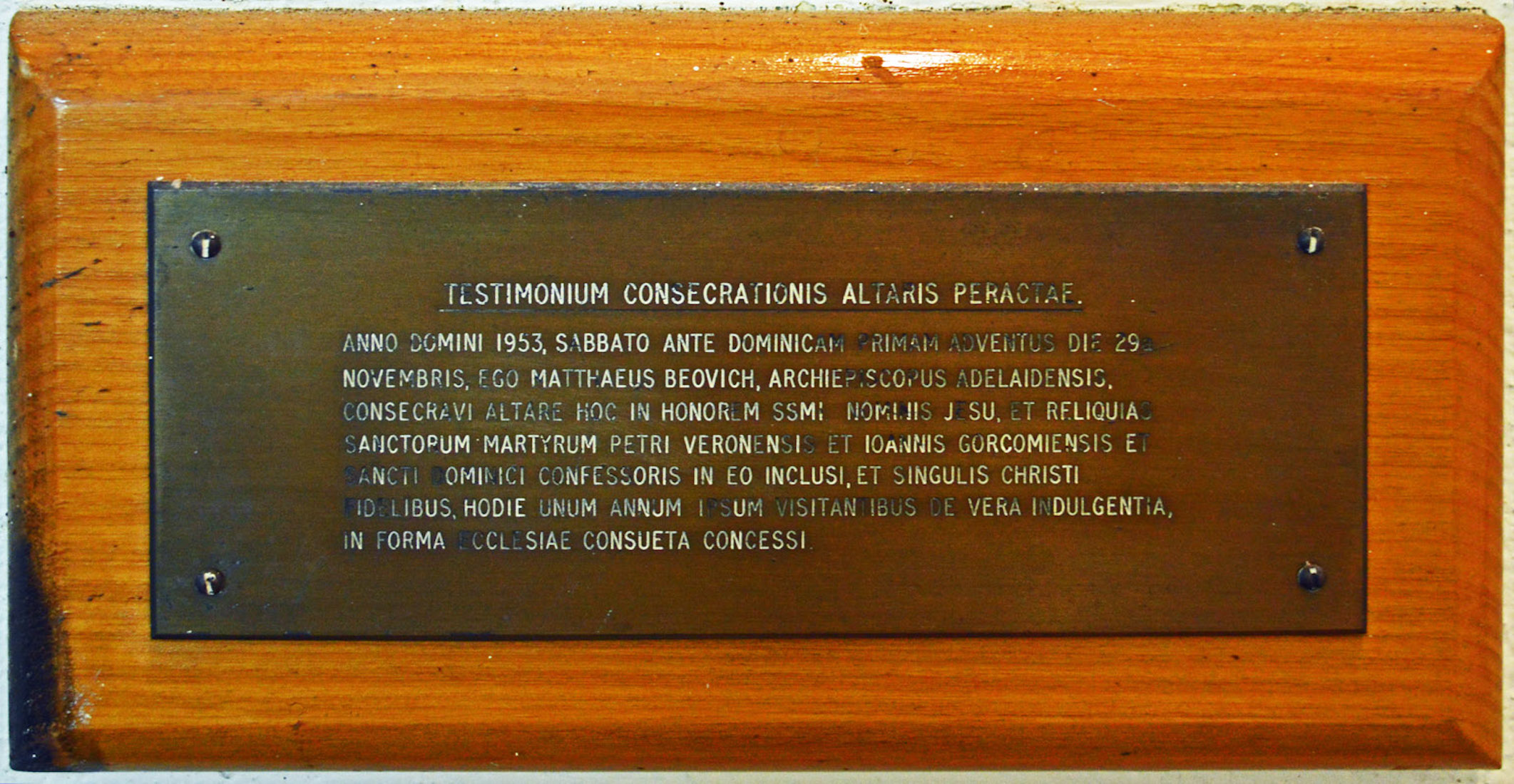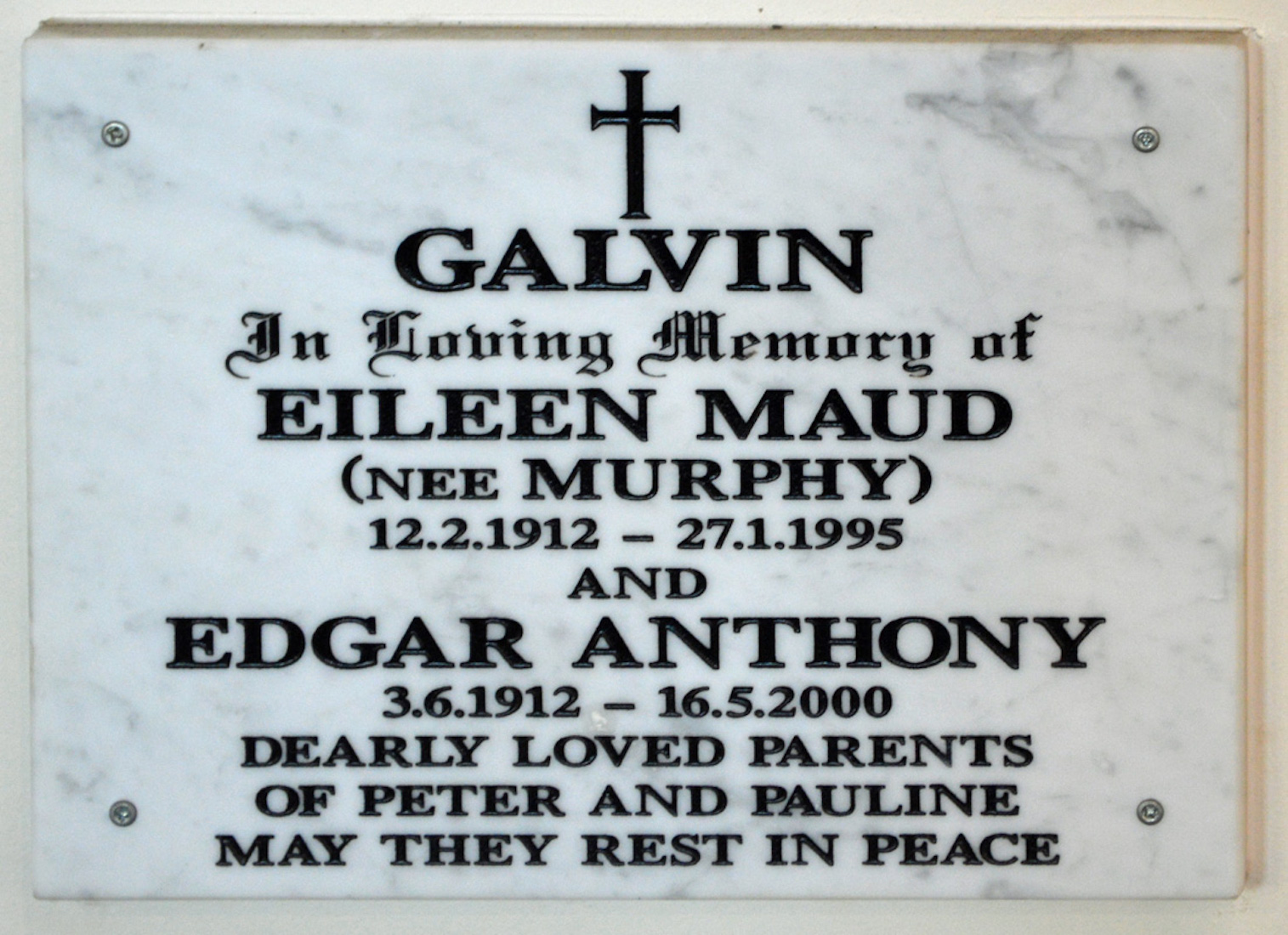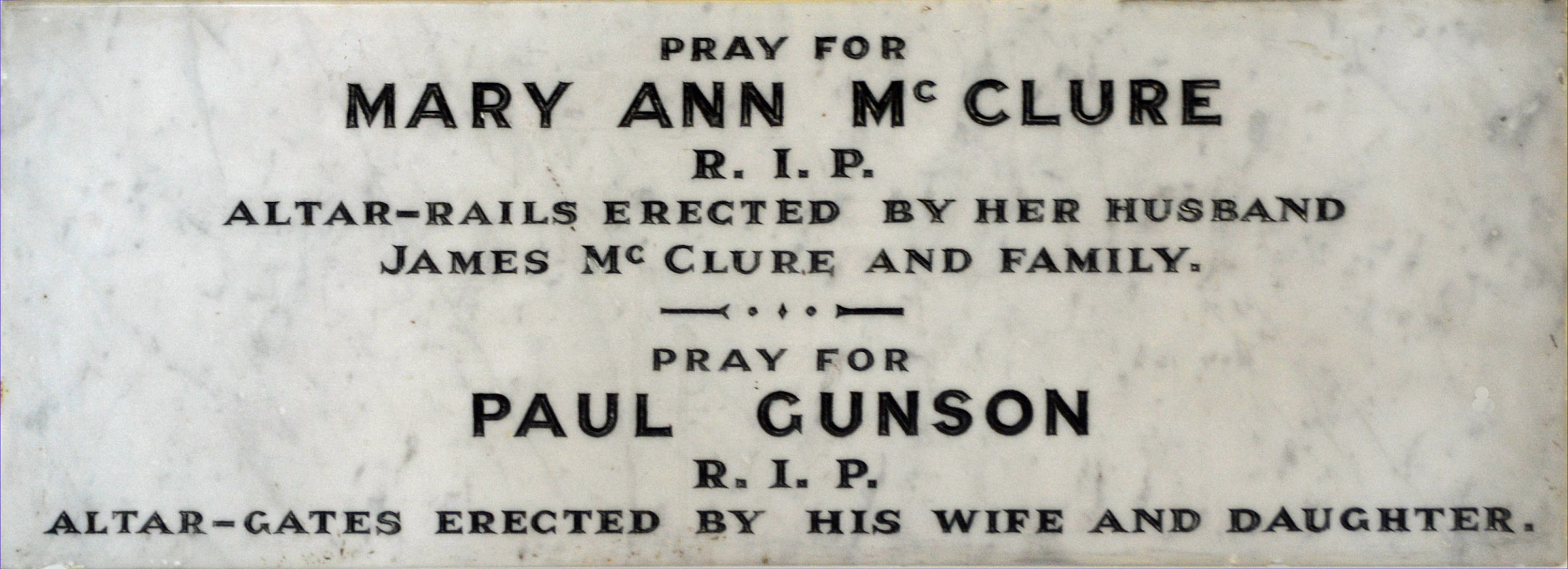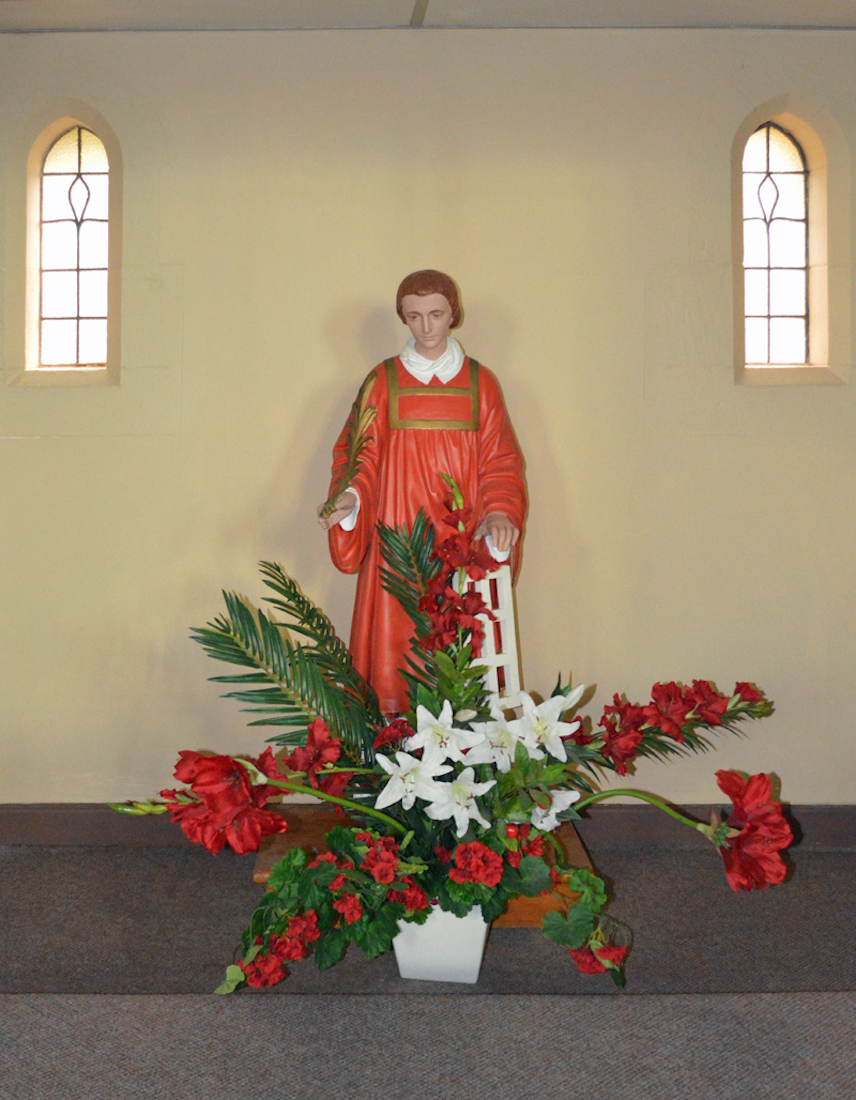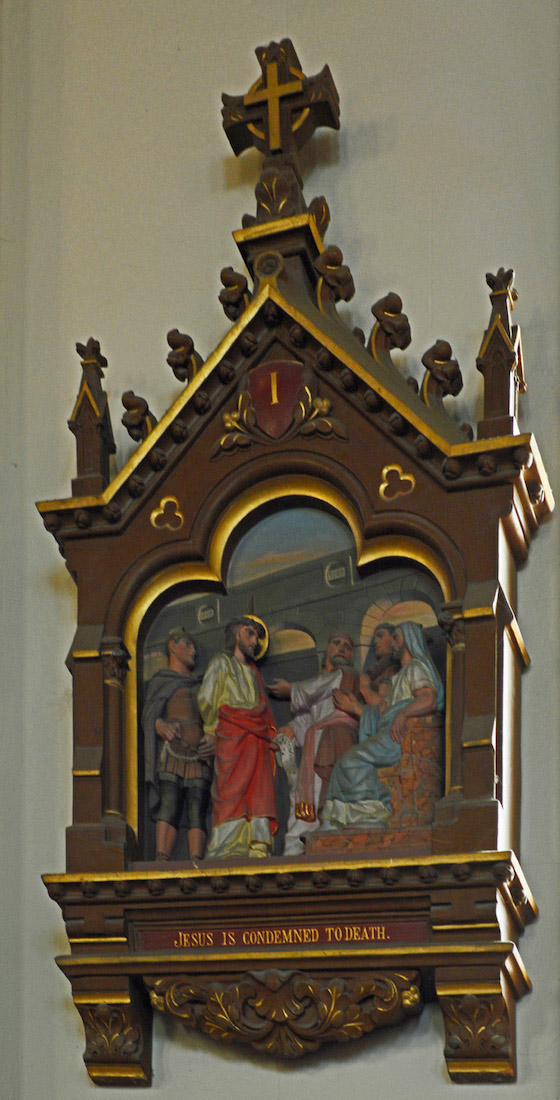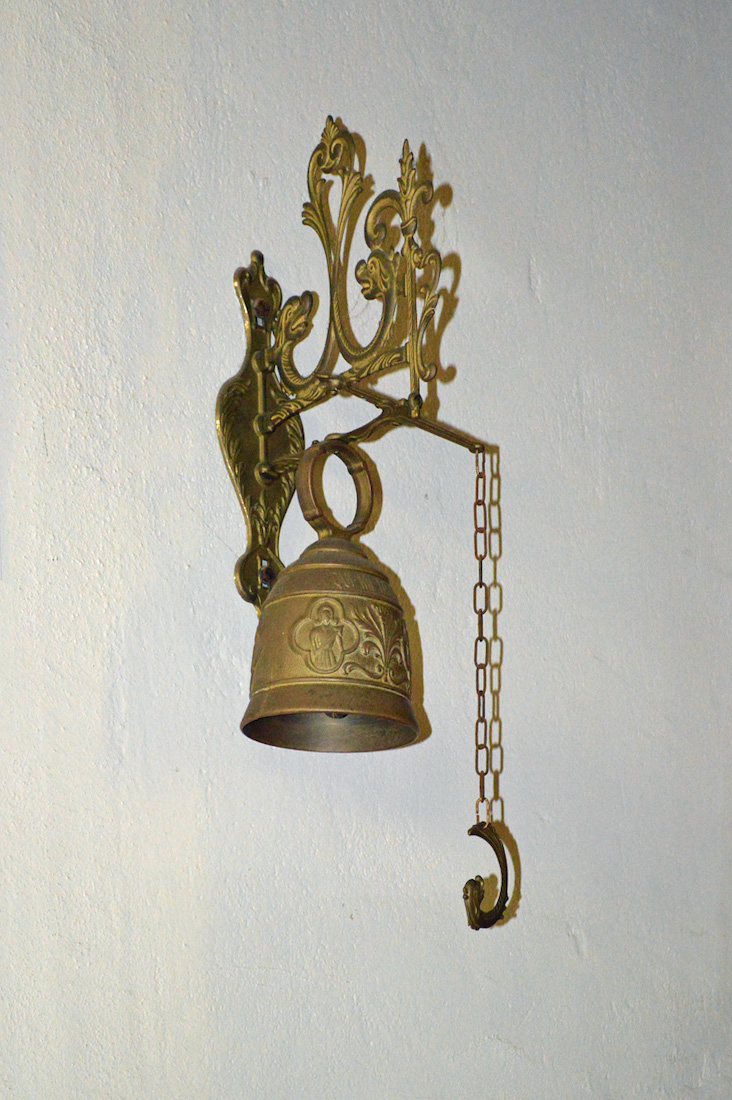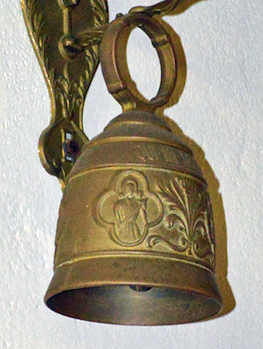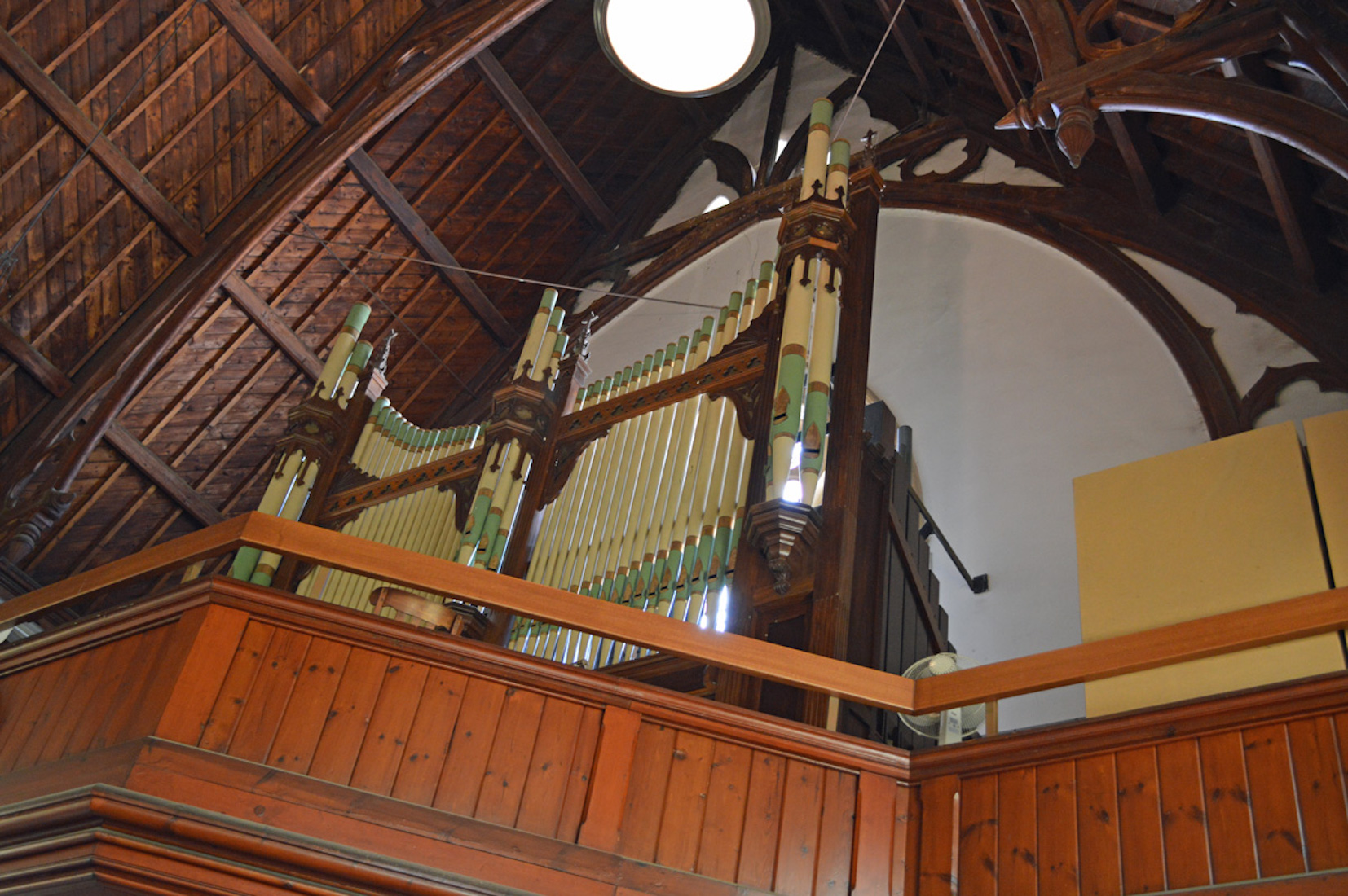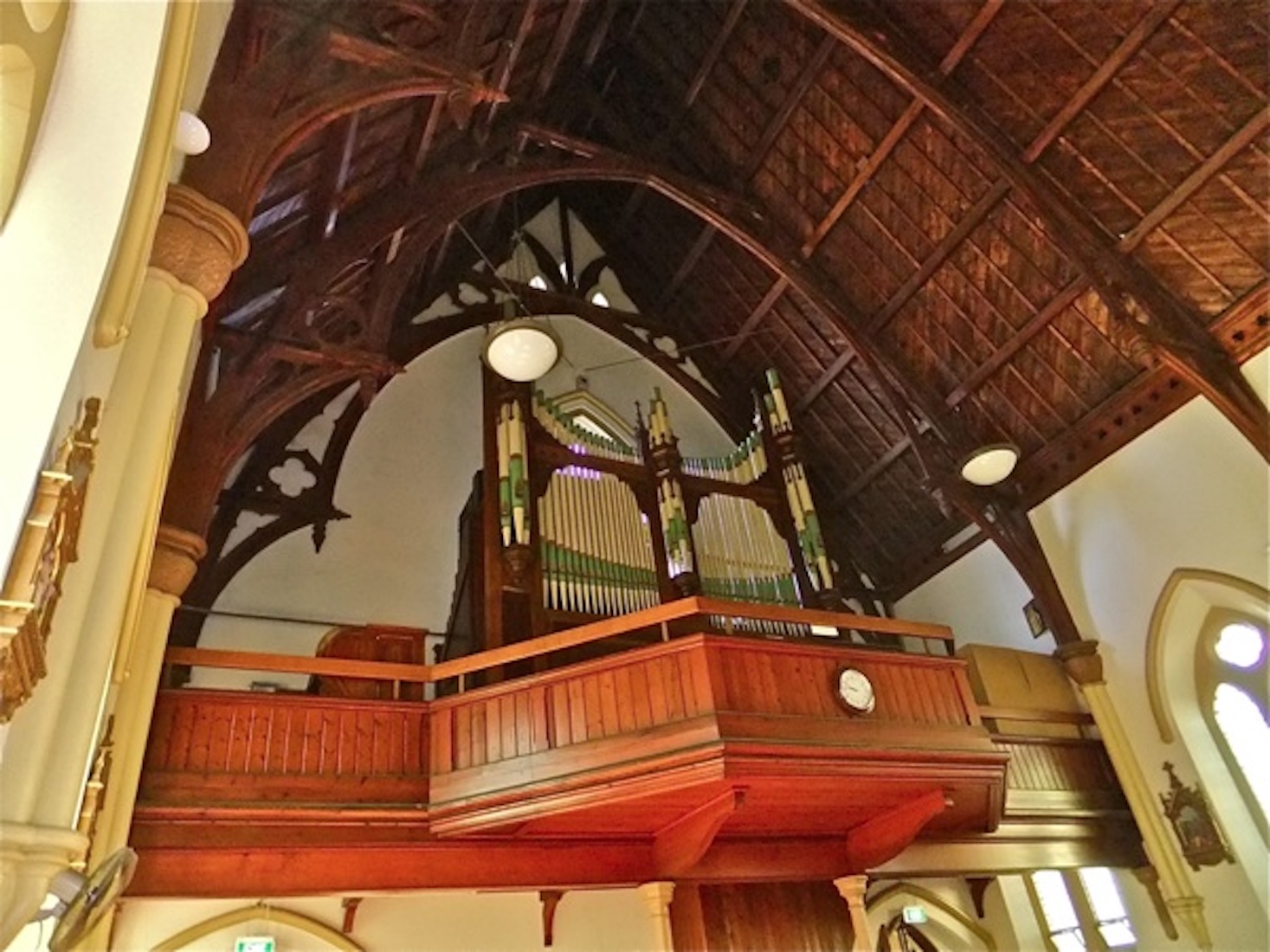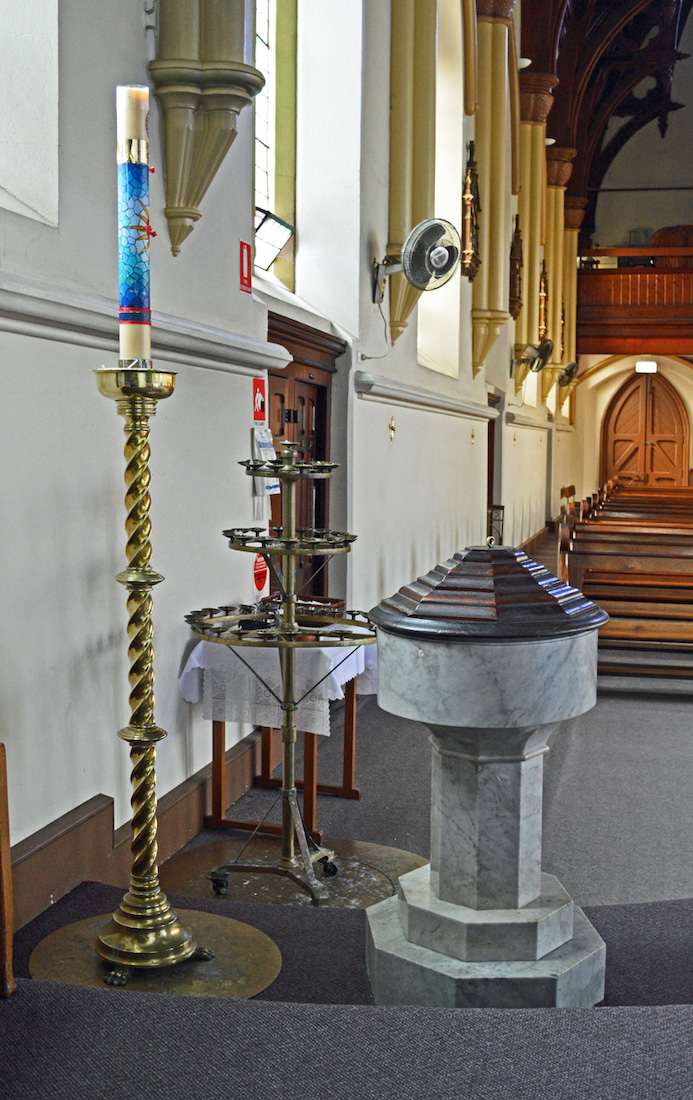
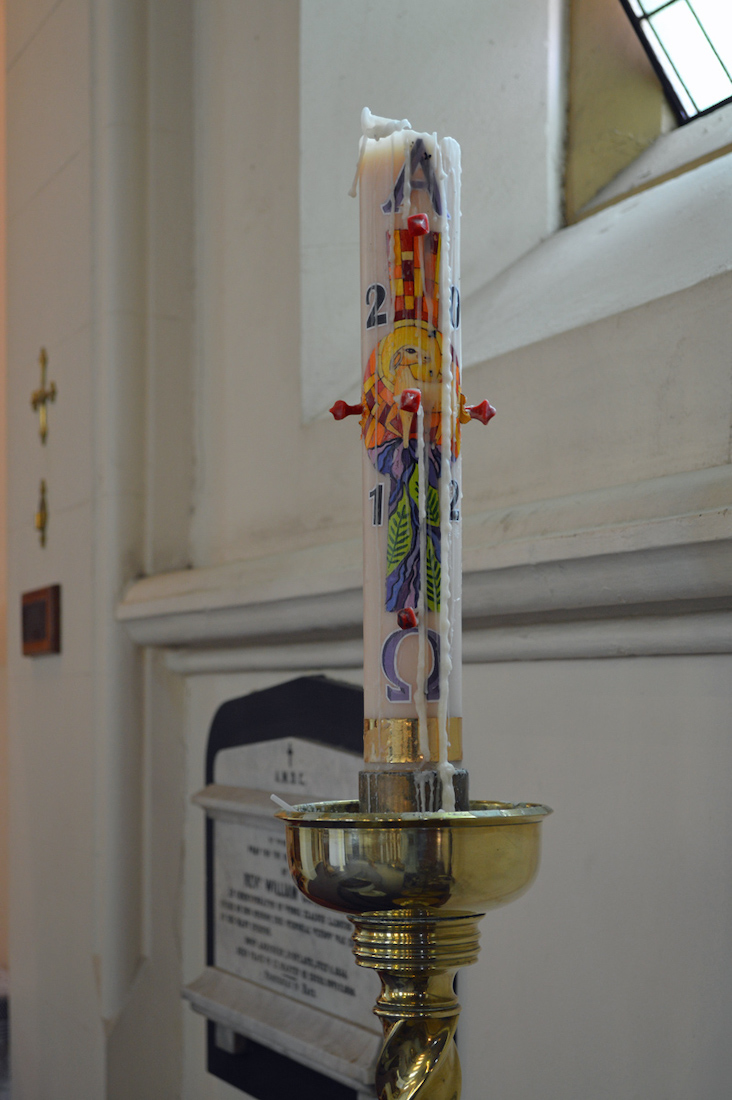
As we move East along the South wall of the nave, we come to the baptismal font and the paschal candle. During the history of this Church, the font has been sited in various locations. The paschal candle is a large, white candle used in Catholic and Anglican churches. A new paschal candle is blessed and lit every year at Easter, and is used throughout the paschal season which is during Easter, and then throughout the year on special occasions, such as baptisms and funerals. INDEX
22. SOUTH NAVE PLAQUES
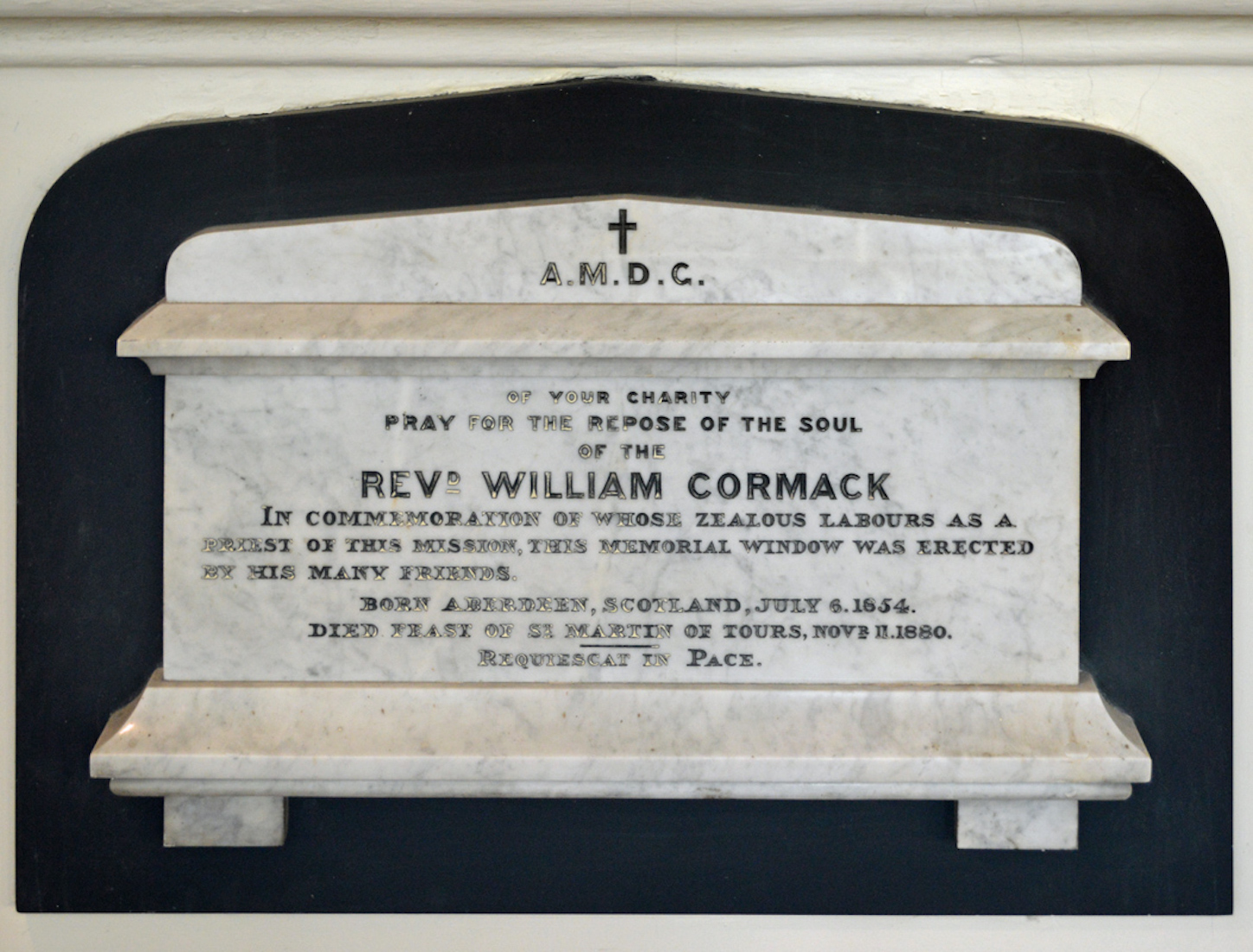
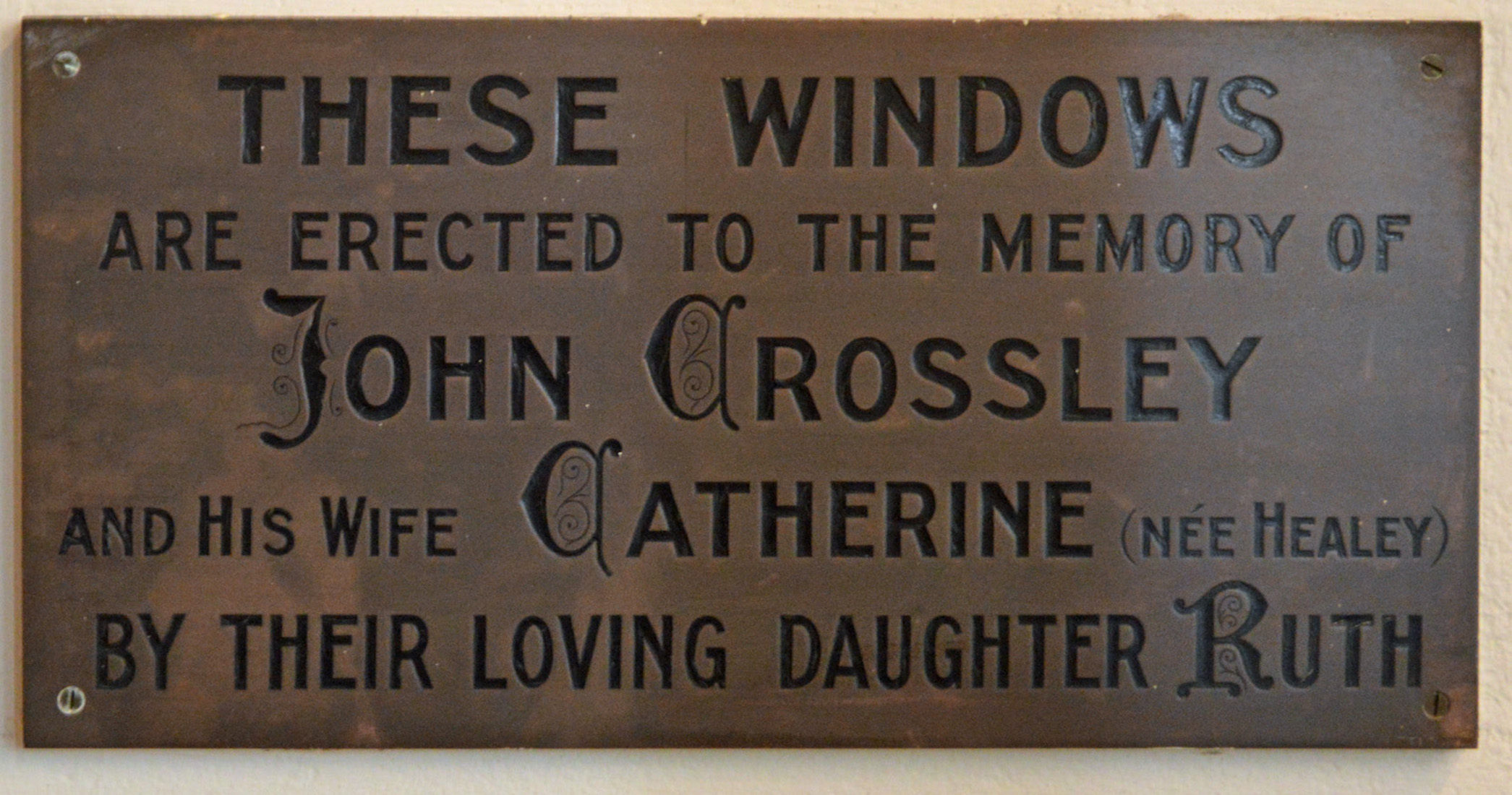
Also in this Southeast corner are several plaques. The left plaque above celebrates the life of a hard working priest in the Church. The plaque at right is a little more mysterious, as the adjacent windows are quite plain! The four front windows of the nave, two on either side, were once coloured. They were made of coloured paper placed between plain glass, and heavily leaded. With age and heat the paper crumbled into dust, so in 1948 – 49, the windows were replaced. However, the accompanying plaque was retained, leading to a nice little mystery.
23. ROSARY CHAPEL WINDOWS
23. There are two lovely windows in the Southeast chapel: the Assumption of our Lady, and the Good Shepherd. They were also erected in memory of John Crossley and his wife Catherine (Healey) by their daughter, Ruth. The Assumption of the Virgin Mary into Heaven, according to the beliefs of the Roman Catholic Church, was the bodily taking up of the Virgin Mary into Heaven at the end of her earthly life. The Catholic Church teaches as dogma that the Virgin Mary ‘having completed the course of her earthly life, was assumed body and soul into heavenly glory.’
24. ROSARY CHAPEL ALTAR
In 1948 it was decided to mark the Golden Jubilee of the Dominican Order in Adelaide and Australia by having St Laurence’s Church consecrated. As part of this, the Altar of Our Lady of the Rosary was erected in the Southeastern chapel. The statue of the Queen of the Rosary was donated by the Rosary confraternity.
25. FRONT ALTAR
In the wake of Vatican II, a majority of Roman Catholic churches installed a freestanding main altar (for the Eucharistic celebration), usually somewhere forward of the traditional high altar. This new marble altar in St Laurence’s Church was put in by Fr Denis Crowley in 1967. It was consecrated that same year by Archbishop Gleason. We observe the Chi-Rho symbol (standing for ‘Christ’) on the outward facing surface. Notice too the fine marble altar rail behind.
26. SAINTS
A sculpted figure stands on either side of the sanctuary. At left is St Thomas Aquinas, donated by Mr Robert Britten Jones to the memory of his mother Adeline May. At the base is inscribed: ‘Pray for Adeline May Britten Jones’. At right is St Joseph, donated by Mrs N. Davis to the memory of her husband Clement Bruce Davis. At the base of the statue is inscribed: ‘Pray for Clement Bruce Davis R.I.P.’ Thomas Aquinas was an Italian Dominican priest, and an immensely influential philosopher and theologian of his time.
28. OUTER APSE WINDOWS
The stained glass windows in the sanctuary of St Laurence’s are interesting, even if they are ‘not the finest in quality and design’. The three pairs of windows in the apse represent six Dominican saints. In the outer windows depicted here, we see from the left: St Catherine de Ricci, St Thomas Aquinas, St Vincent Ferrer, and St Rose of Lima. These windows were donated by Donald MacLean.
29. EAST WINDOWS
The central pair of apse windows are largely hidden from public view because they sit behind the reredos. The depiction here is actually a composite photographic collage! Shown here are St Dominic and St Catherine of Siena. This pair of windows were erected by the parishioners to the memory of Fr Joseph Bannon O.P, the first member of the community to die in Adelaide and to be buried in the Church plot in West Terrace Cemetery.
30. HIGH ALTAR
This main altar, which is exactly the same in design, though not in size, as the altar in the Dominican Sisters’ chapel in Teschemakers, N.Z., was erected in 1926 in memory of John Lewis and his daughter, Alma. It was consecrated by Archbishop Spence. At the time, the original main altar of cedar was divided to make the two altars in the side chapels.
31. HIGH ALTAR PANEL
Across the base of the main altar is an impressive bas-relief carving of the Last Supper.
32. TABERNACLE AND CRUCIFIX
Central to the main altar are an attractive brass crucifix and tabernacle. The original single door of the tabernacle was replaced by the more convenient pair of doors in 1948. The tabernacle is the fixed, locked box in which the Eucharist is ‘reserved’ (stored). A crucifix (from Latin cruci fixus meaning ‘(one) fixed to a cross’) is an image of Jesus on the cross, as distinct from a cross with no body.The crucifix is a principal symbol for many groups of Christians.
33. ALTAR FIGURES
These two figures stand on either side of the main altar. The figure on left is St Dominic with a Rosary, Bible in hand, and obviously teaching. Dominic, who lived 1170 – 1221 was a Spanish priest and founder of the Dominican Order. He is also the patron saint of astronomers. The figure on the right is St Laurence. He holds a Bible and a quill, and a representative iron grill, signifying the agonizing death he suffered by roasting over a fire. St Laurence is also known with the spelling ‘St Lawrence’. He is one of the most venerated Roman martyrs, and his feast day is August 10th,
35. HOLY NAME ALTAR
The Holy Name Altar was erected in the Northeastern chapel in 1948 as part of the Golden Jubilee of the Dominican Order in Adelaide and Australia. The statue of the Holy Name was donated by the Holy Name Society. The Holy Name Society in St Laurence’s was founded in 1922 by Fr Vincent McEvoy, and was the first branch in Australia.
36. NORTHEAST NAVE PLAQUES
Several plaques adorn the walls in the Northeastern corner of the nave. At right is a memorial to Eileen Maud and Edgar Anthony Galvin. At bottom is a plaque in memory of the donors of the marble altar rail and brass altar gates erected ca 1948. The brass plate (top left) commemorates the consecration of the Holy Name Altar by Archbishop Beovitch on 29th November, 1953.
37. ST LAURENCE AND STATION
Now moving back up the North wall of the nave we come to another niche with the figure of St Laurence after whom the Church is named. When the Prefect of Rome ordered Laurence to bring him the church’s riches, he brought the poor and needy, saying ‘This is the Church’s treasure!’ The Prefect was so enraged that he condemned Laurence to a slow cruel death of roasting on an iron grill. The figure is shown symbolically holding the grill. At right we see another of the Church’s Stations of the Cross. This is Number I, in which Jesus is condemned to death.
38. WEST WALL BELL
On the West wall hangs this old bell. It is used at the beginning of services here, but surely it must have a history!
40. ORGAN II
Our final view of the grand pipe organ concludes our tour of St Laurence’s Church. This gracious old Church needs to be more widely known and enjoyed!


